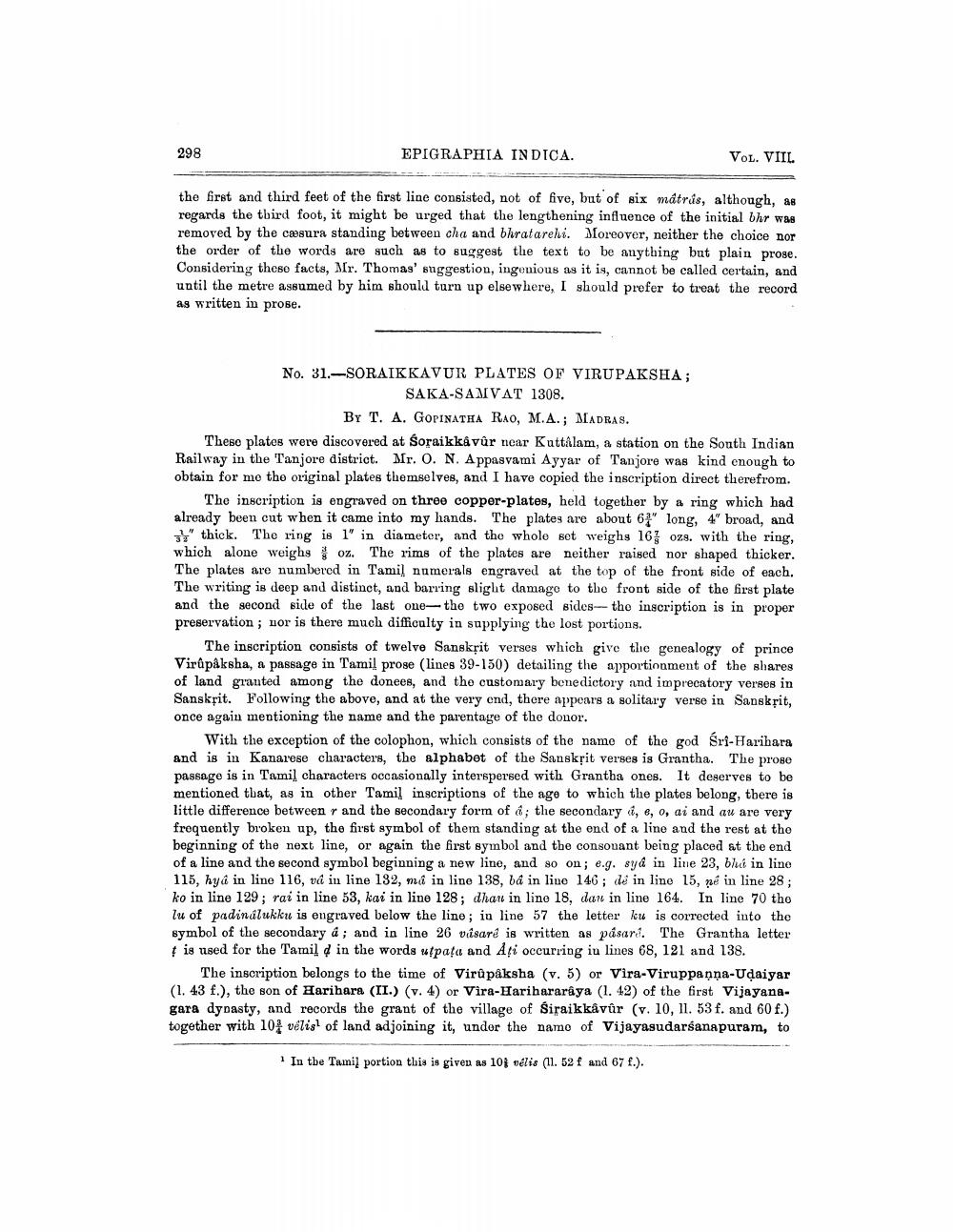________________
298
EPIGRAPHIA INDICA.
VOL. VIIL
the first and third feet of the first line consisted, not of five, but of six mátrás, although, as regards the third foot, it might be urged that the lengthening influence of the initial bhr was removed by the caesura standing between cha and bhratarehi. Moreover, neither the choice nor the order of the words are such as to suggest the text to be anything but plain prose. Considering these facts, Mr. Thomas' suggestion, ingenious as it is, cannot be called certain, and until the metre assumed by him should turn up elsewhere, I should prefer to treat the record as written in prose.
No. 31.-SORAIKKAVUR PLATES OF VIRUPAKSHA;
SAKA-SAMVAT 1308.
BY T. A. GOPINATHA RAO, M.A.; MADRAS.
These plates were discovered at Soraikkâvûr near Kuttâlam, a station on the South Indian Railway in the Tanjore district. Mr. O. N. Appasvami Ayyar of Tanjore was kind enough to obtain for me the original plates themselves, and I have copied the inscription direct therefrom.
The inscription is engraved on three copper-plates, held together by a ring which had already been cut when it came into my hands. The plates are about 63" long, 4" broad, and 3" thick. The ring is 1" in diameter, and the whole set weighs 163 ozs. with the ring, which alone weighs oz. The rims of the plates are neither raised nor shaped thicker. The plates are numbered in Tamil numerals engraved at the top of the front side of each. The writing is deep and distinct, and barring slight damage to the front side of the first plate and the second side of the last one-the two exposed sides- the inscription is in proper preservation; nor is there much difficulty in supplying the lost portions.
The inscription consists of twelve Sanskrit verses which give the genealogy of prince Virupaksha, a passage in Tamil prose (lines 39-150) detailing the apportionment of the shares of land granted among the donees, and the customary benedictory and imprecatory verses in Sanskrit. Following the above, and at the very end, there appears a solitary verse in Sanskrit, once again mentioning the name and the parentage of the donor.
With the exception of the colophon, which consists of the name of the god Śri-Harihara and is in Kanarese characters, the alphabet of the Sanskrit verses is Grantha. The prose passage is in Tamil characters occasionally interspersed with Grantha ones. It deserves to be mentioned that, as in other Tamil inscriptions of the age to which the plates belong, there is little difference between r and the secondary form of &; the secondary a, e, o, ai and au are very frequently broken up, the first symbol of them standing at the end of a line and the rest at the beginning of the next line, or again the first symbol and the consonant being placed at the end of a line and the second symbol beginning a new line, and so on; e.g. syd in line 23, bhd in line 115, hyd in line 116, va in line 132, ma in line 138, bá in line 146; de in line 15, né in line 28; ko in line 129; rai in line 53, kai in line 128; dhau in line 18, dan in line 164. In line 70 tho lu of padinálukku is engraved below the line; in line 57 the letter ku is corrected into the symbol of the secondary á; and in line 26 vasarê is written as pásard. The Grantha letter is used for the Tamil d in the words utpata and Ați occurring in lines 68, 121 and 138.
The inscription belongs to the time of Virupaksha (v. 5) or Vira-Viruppanna-Uḍaiyar (1. 43 f.), the son of Harihara (II.) (v. 4) or Vira-Harihararaya (1. 42) of the first Vijayanagara dynasty, and records the grant of the village of Siraikkâvûr (v. 10, 11. 53 f. and 60 f.) together with 10 velis1 of land adjoining it, under the name of Vijayasudarsanapuram, to
In the Tamil portion this is given as 10 vélis (11. 52 f and 67 f.).




